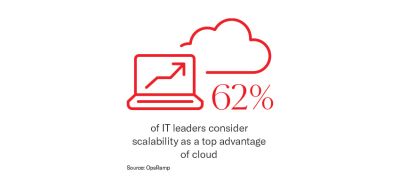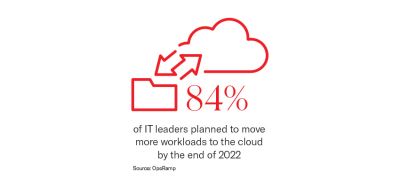Scalability in cloud computing is the ability to increase or decrease IT resources to respond to changing business needs. Scalability in the cloud is much more achievable than in an on-premise environment. This is why many businesses opt for cloud migration.
Research by OpsRamp revealed that 62% of IT decision-makers consider scalability as a primary benefit of cloud infrastructure. But what is scalability and how does it drive business growth? This insight explores the benefits, challenges, and best practices of scalability in cloud computing.

Understanding scalability in cloud computing
Cloud systems have the ability to scale up their storage, computing power, and networking capabilities while still utilizing their existing hardware resources. Scalability enables consistent, long-term growth and works well for businesses with strategically planned, predictable or cyclical changes in workload.
If cloud scalability is about adapting to long-term growth, cloud elasticity works by increasing or decreasing cloud resources in the short term, according to unpredictable changes such as sudden spikes in website traffic or a temporary increase in the number of service users.
Many cloud services are scalable and elastic, but it is essential to consider organisational needs before deciding what works best. The next section details some of the benefits of scalability in cloud computing.
Benefits of scalability in cloud computing
According to research by OpsRamp, 84% of surveyed IT leaders planned to move more workloads to the cloud by the end of 2022 because of its many advantages, including scalability. Additionally, Gartner predicts cloud spending will grow by 20.7% in 2023.

Benefits of scalability in a cloud infrastructure include:
Cost efficiency
Subscription-based cloud services mean that companies only pay for what they use and do not have to sustain the costs of maintenance or physical hardware. This also reduces potential disaster recovery costs.
Flexibility
Cloud infrastructure is scalable thanks to virtual machines, which emulate the functionality of physical hardware within a server environment. Third-party cloud providers offer flexible virtual machines that can be hosted on multiple servers at once and allow for workloads to be transferred to larger or smaller machines.
Improved performance and speed
Upscaling and downscaling resources can be done almost instantly with an easy configuration process, minimising the risk of downtime to keep services accessible.
Reliability
Scalable cloud environments are secure and can sustain increasing or decreasing demand with minimal risk of data loss.
Challenges of scalability in cloud computing
Despite its many benefits, creating a scalable cloud environment requires extensive planning and testing. Some of the challenges that might arise are:
- Complexity – For large organisations with big infrastructures, system complexity can get in the way of scalability.
- Interoperability – Different cloud providers have different approaches to scalability, which can be a challenge for businesses relying on multiple providers.
- Service disruptions – If systems are not optimised for scalability, performance can be impacted, causing service disruptions.
- Security – Organisations might be more vulnerable to cyber security breaches while scaling and moving workloads
Best practices for scalability in cloud computing
Organisations need to identify the best strategy for cloud scalability in order to prevent challenges. There are three different types of cloud scalability:
- Vertical scaling involves adding or reducing processing power or RAM to an existing server by using expansion units. In some cases, performance might be affected due to the server’s limited size and capacity.
- Horizontal scaling involves adding or removing servers from an existing cloud infrastructure. This process is usually more complex because it involves independent servers working on a single system, but it is the best solution for organisations wanting to scale up or down with no limitations.
- Diagonal scaling is a combination of the previous two. Organisations can grow vertically until they reach capacity, and then clone the servers to meet demand. This option allows for greater flexibility in scaling up or down, which is ideal for organisations facing unpredictable changes.
Conclusion: Reap the benefits of scalability in cloud computing
Scalability is the biggest driver of cloud migration for businesses. Whether you’re scaling vertically, horizontally, or diagonally, planning with the future in mind is essential to reap the benefits. ROCK can help you understand your infrastructure requirements and define the best scalability strategy for your organisation. Discover our cloud and platform services to keep growing while saving costs.